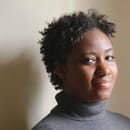What if institutions like The New School had no Black students? What if The New School had no people-of-color to sprinkle into their new student brochures and no non-white faculty to add flavor to the class schedules? Would white students be here? During college searches, institutions presented diversity and inclusion as gifts to minorities, especially Black folks like me. All of the TV shows of my generation, with the Black best friend or token Asian, or helpful Hispanic person, reinforced this part of American culture. They told us to graciously accept our diversity roles without discussing the toll it takes to be Black or not white in a white supremacist institution. However, the truth is for all the suffering and inequality non-white, and particularly Black American students, go through for education, we get little in return. While institutions like The New School put a price tag on diversity, education has become a battlefield for non-white students. According to IPEDS (The Integrated Postsecondary Education Data System), for the 2013 cohort, only 57% of first-time, full-time Black students graduated, and 16% of first-time, full-time students dropped out. There could be many reasons why almost half of The New School’s Black students left, but personally, I imagine they got tired of being “diversity slaves.”
I know how it feels to be a “diversity slave” only because of the small moments when I was relieved from The New School and had the freedom to really learn. I have participated in 2 short internships, my work has been published in a print anthology and in an online magazine, and I produced a podcast. All these experiences have expanded my horizons and connected me to a diverse group of writers, artists, and editors, who have challenged my thinking, and have made me a better person, student, and citizen. However, not one of these opportunities came from The New School or any connection to the school. The New School comparatively has created an environment where I feel I have to be constantly on defense to protect my emotional well-being.
All I really wanted was an education, and I quickly found that at The New School, you had to be rich and white to get that. Everybody else was here to serve. People of color serve up action sequences when we fight for our humanity in classes to give white students a diverse perspective. We serve up our privacy when we have to educate white students about making art that isn’t violent by excluding real people. We serve up our creativity when we are drained and are forced to create things to challenge white supremacy. I have taken not one class at The New School that has shown me how to create, journal, or write, to heal rather than reopen wounds.
This most definitely doesn’t make me a real slave. Modern-day slavery is way darker than having to talk about the Derek Chauvin trial in class. What I mean by “diversity slave” is a person of color who was falsely drawn to an institution by the claim of inclusion yet has to either erase or perform to survive. A diversity slave has to simply sit through students and faculty constantly fumbling through conversations about race or has to put their emotional and mental well-being on the line to educate. A diversity slave has the choice of letting another microaggression slip by or drain themselves by educating the 7th person of the day on why the thing they said was rude, ignorant, and personally hurtful. Diversity slaves have to constantly humanize their entire race in the classroom because nobody else is there to do it. They must do this work or stay silent. Personally, this feels like slavery because there really isn’t a choice that protects the person from exerting emotional energy that won’t distract them from learning. It is impossible to learn and thrive under these circumstances.
In my first year at The New School, my professor screened a documentary about food insecurity. In between tearful confessionals from parents sending their children to bed without supper to mask that there was nothing in the house to feed them with, my classmates, all white, mostly women, peaked at their phones. The documentary landed on the cycle of poverty and how these people, Black people, would be hungry until somebody came to save them. That very same morning, The New School food pantry gave me canned corn, a can of pineapples in light syrup, and two cans of baked beans. I thought of this as I watched hopeless individuals brought to tears with a studio camera on their heels as they fought to feed themselves and their families. Then came the discussion. The professor nicely pushed us, reminding us that participation was a part of our grade. The documentary, for me, wasn’t educational; it was traumatizing. However, it may have been bearable if I didn’t have to contemplate how my grade would be calculated if I didn’t speak.
I spoke with other New School students to challenge my ideas and find out if my feeling of being a diversity slave was exclusive just to me. Many students felt like exploitation for their racial background was a set norm. Devon, a student graduating from the Journalism and Design Department with a Culture and Media Minor, says there are classes where she “didn’t learn a thing” because of the constant battle inside over whether or not to educate or preserve her energy. During a quick zoom interview during finals, she said, “Throughout my academic career at The New School, I kind of had taken a backseat in terms of educating people. Just because I felt as though… I don’t know… I didn’t want to start anything, which is my own fault… I was just tired.” She also explained how these feelings were coupled with some classes where she had to do extra work to challenge whiteness in the syllabus for herself and other students when she later became a TA.
Alexia, a Lang Theater major and Literature Minor, does say “diversity slave” may not describe her experience. “I feel in a slave mentality I’m educating, and that is not my job.” She goes on to compare her experience less with that of a slave but of the next iteration of slavery, sharecropping. “I feel like I could say a sharecropper. I’m free. You’re still reaping the benefits from me. Though I am speaking my voice, you’re reaping the benefits from me.” After describing having to teach the whole section on race in a mandatory literature class, she explains she’s free because of the empowerment that comes with sharing her voice, while at the same time, “…as a slave, as a diversity slave, I definitely feel like the mule in the situation and I’m just being yanked. I feel like it’s almost in a way that the information that I personally learned by myself from just wanting to be educated as a person on all levels has been kind of yanked out of us, drained from us, in not a giving manner. It’s not given. It’s being taken. And that is slavery.”
The diversity slave is the product of an institution with desegregation without integration and inclusion. This school has not once offered me adequate resources to get an equal education to my fellow white students, even when the FAFSA (an already flawed calculation system) calculated that my expected family contribution was zero. Nikole Hannah-Jones said it best on the podcast The Axe Files with David Axelrod that “desegregation” is not “integration.” While remembering being one of 5 students in a white elementary school, she said, “That was allowing a handful of us into someone else’s school where we did not share in that school’s culture. It never was our school. I believe in integration which is not about tokenism. It’s not just one way. It includes the educators, where we are actually building schools that serve multiple populations.” After the 2018 – 2019 school year, only 75 Black students graduated with a Bachelor’s degree at The New School. However, 485 Black full-time students were enrolled four years prior for four-year degrees. Deserting Black students in a white supremacist institution is a quick fix that not only doesn’t solve the problem but has put my education and sanity at risk.
The trauma that goes with being what I call a New School diversity slave isn’t something that can be easily repaired, and it will affect our mental, emotional and physical health long after our degrees are mailed out. Healthline now defines racial trauma as “a reaction to experiences of racism, including violence or humiliation. You might also hear it referred to as race-based trauma or race-based traumatic stress. All types of trauma, including racial trauma, can contribute to the development of post-traumatic stress disorder (PTSD), a mental health condition marked by a range of mental and physical effects.” In an article for Refinery 29 called How The Racial Trauma Of 2020 F*cked With Our Bodies & What To Do About It in 2021, Kathleen Bremang talked with mental health professionals about the physical effects of racial trauma that include irreversible diseases such as high blood pressure. She writes, “These signs should not be dismissed or ignored. Dr. Crawford says the symptoms she sees from people who are experiencing race-related trauma are the same symptoms of post-traumatic stress disorder (PTSD), including high blood pressure, difficulty concentrating, sleeping, and increased anger and irritability.” It took me four years at The New School to realize that problems with my menstrual cycle, pain in my fingertips, and increased anxiety would always appear in tandem with my class schedule.
Although The New School’s brochures are full of non-white students, without counting international students, In 2019, students of color made up 29% of enrollment, and only 5% of students were Black. This counts graduate students and degree non-seeking students. Almost as if this were a whole scam to lure a few students of color here to give white students the benefit of diversity. Diversity is for white people, and allowing a few seats at the table doesn’t fix years of inequality. It does, however, put people of color and particularly Black people in the line of duty for battles that they never asked for. The New School gaslights its students by continuing to knowingly promote a system in which diversity can be commodified on advertisements yet requires students to be in crippling debt. Students of color are worth more than what we get out of this educational system and way more than The New School has earned marketing themselves as diverse while creating a system full of diversity slaves.
The New School profits off Black bodies and brutalizes our minds in the process. Racism is taught at The New School as somebody else’s problem. Racism is taught as the KKK’s problem, racism is taught as a Trump supporters’ problem, racism is taught as a republican individual’s problem, yet race is never talked about in terms of the most tangible, which is your problem. Racism is your problem. The New School sends emails about justice and accountability and continues to gaslight us with those words because justice and accountability will never be a part of this school, your school, as long as its advertisements, learning style, and earnings are attached to “diversity slaves.” I call for abolition now.


